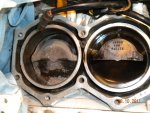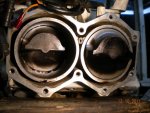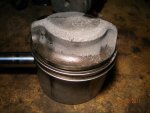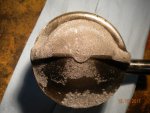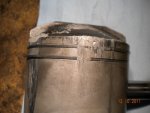Got a 1981 v4 Johnson 140, just rebuilt (all the necessary info here: http://forums.iboats.com/showthread.php?t=511125).
Took her out for the some more break-in (two hours of up-and-down on the throttle...just a couple or runs at open throttle), after much checking in our test tank at home. Motor ran great for the initial break-in, save for an open throttle running issue, which turned out to be a semi-kinked fuel line. Motor would go to WOT for 15 seconds, and then feel like it was running out of gas, and run down to 3500 for a few seconds and pick up and go WOT for a few seconds again.
We put an elbow in from the fuel pump outlet to the carb lines and fixed that. Took it out last weekend and the thing practically JUMPED out of the water (and this is a 19' deck boat with and 8' beam...just me and my lady on it this time, light load), and at WOT it was hitting 5400 rpm. We ran it at WOT for about 2 minutes (since it only had a couple of hours on it so far), but on the second WOT run, she died. Decided to let it cool (as it wouldn't start again...besides, the fish were biting!) and got it going, but with a bad miss and no power over 3000 or so.
We putted back to our ramp, about two miles. Brought her home and checked compression. Cyls 1,2,3 were around 120, #4 was maybe 10 psi. I pulled the bypass cover and the rings on #4 were still springing out. Pulled the PH and removed the #4 piston to find that on the piston, opposite the intake ports, the piston had melted and seized the rings. The plug was covered in aluminum flakes, obviously shorting the surface gap plug, as was the piston. All the sharp contours on the piston had burned round, and the piston was covered in the same flaking (grey, not magnetic). The exhaust side of the piston (where the rings were melted into the piston) has serious flaking on the piston crown. The newly bored cylinder walls were scuffed, but not bad. I've honed them and they have good cross-hatching and no grooves. We've replaced the piston (my girl is quite the mechanic, needle bearings in a connecting rod, she's got the touch for them!) and I think it'll seal well.
My question is, why? I'm looking over the forums and looking for common causes, and I'm going to look at the carb jets for that cylinder. I rebuilt the carbs last year, maybe some junk in the jet? There is no filtering in the fuel lines other than the screen in the fuel pump. Should I add a filter in the lines before the pump? We have both heads off and the other pistons have a light coating of carbon on them, but the #4 looks like it might have been lean...a little carbon, but not much and dry when we removed it. It was a VRO engine, but that has all been removed, and we're pre-mixing at 25:1 for the break-in.
I've read about "double firing", and I have the flywheel indexed. Is that a common problem too? What causes double firing? The timer base has been replaced, and the idle timing is set at 4 degrees, although I still need to check the WOT timing.
Sorry for being so lengthy, just want to give all the info I can. I've been an auto and aviation mechanic for years, and know my way around engines. I've heard about the reliability of the the jonnyrude, but to me, they seem very finicky....one small issue can cause major damage. Love the power of the thing though, when it's running right. Was pushing this big boat at 35 (speedo, not GPS yet) with, i think, the only thing in the water was the prop!
Took her out for the some more break-in (two hours of up-and-down on the throttle...just a couple or runs at open throttle), after much checking in our test tank at home. Motor ran great for the initial break-in, save for an open throttle running issue, which turned out to be a semi-kinked fuel line. Motor would go to WOT for 15 seconds, and then feel like it was running out of gas, and run down to 3500 for a few seconds and pick up and go WOT for a few seconds again.
We put an elbow in from the fuel pump outlet to the carb lines and fixed that. Took it out last weekend and the thing practically JUMPED out of the water (and this is a 19' deck boat with and 8' beam...just me and my lady on it this time, light load), and at WOT it was hitting 5400 rpm. We ran it at WOT for about 2 minutes (since it only had a couple of hours on it so far), but on the second WOT run, she died. Decided to let it cool (as it wouldn't start again...besides, the fish were biting!) and got it going, but with a bad miss and no power over 3000 or so.
We putted back to our ramp, about two miles. Brought her home and checked compression. Cyls 1,2,3 were around 120, #4 was maybe 10 psi. I pulled the bypass cover and the rings on #4 were still springing out. Pulled the PH and removed the #4 piston to find that on the piston, opposite the intake ports, the piston had melted and seized the rings. The plug was covered in aluminum flakes, obviously shorting the surface gap plug, as was the piston. All the sharp contours on the piston had burned round, and the piston was covered in the same flaking (grey, not magnetic). The exhaust side of the piston (where the rings were melted into the piston) has serious flaking on the piston crown. The newly bored cylinder walls were scuffed, but not bad. I've honed them and they have good cross-hatching and no grooves. We've replaced the piston (my girl is quite the mechanic, needle bearings in a connecting rod, she's got the touch for them!) and I think it'll seal well.
My question is, why? I'm looking over the forums and looking for common causes, and I'm going to look at the carb jets for that cylinder. I rebuilt the carbs last year, maybe some junk in the jet? There is no filtering in the fuel lines other than the screen in the fuel pump. Should I add a filter in the lines before the pump? We have both heads off and the other pistons have a light coating of carbon on them, but the #4 looks like it might have been lean...a little carbon, but not much and dry when we removed it. It was a VRO engine, but that has all been removed, and we're pre-mixing at 25:1 for the break-in.
I've read about "double firing", and I have the flywheel indexed. Is that a common problem too? What causes double firing? The timer base has been replaced, and the idle timing is set at 4 degrees, although I still need to check the WOT timing.
Sorry for being so lengthy, just want to give all the info I can. I've been an auto and aviation mechanic for years, and know my way around engines. I've heard about the reliability of the the jonnyrude, but to me, they seem very finicky....one small issue can cause major damage. Love the power of the thing though, when it's running right. Was pushing this big boat at 35 (speedo, not GPS yet) with, i think, the only thing in the water was the prop!




















